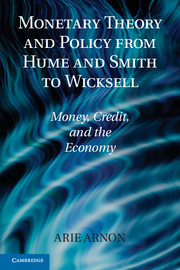Book contents
- Frontmatter
- Dedication
- Contents
- List of Illustrations
- List of Tables
- Preface
- Introduction
- Part one Analytical and Historical Foundations
- Part two Debating Monetary Theory under Inconvertibility
- Part three Debating
- 10 From the Resumption to 1837More Crises
- 11 The Currency School Trio
- 12 The Banking School Trio
- 13 Neither Currency Nor Banking School
- Part four The Road to Defensive Central Banking
- Part five A New Beginning
- Bibliography
- Author Index
- Subject Index
10 - From the Resumption to 1837More Crises
Published online by Cambridge University Press: 05 July 2014
- Frontmatter
- Dedication
- Contents
- List of Illustrations
- List of Tables
- Preface
- Introduction
- Part one Analytical and Historical Foundations
- Part two Debating Monetary Theory under Inconvertibility
- Part three Debating
- 10 From the Resumption to 1837More Crises
- 11 The Currency School Trio
- 12 The Banking School Trio
- 13 Neither Currency Nor Banking School
- Part four The Road to Defensive Central Banking
- Part five A New Beginning
- Bibliography
- Author Index
- Subject Index
Summary
Introduction
The debate over the monetary system and a possible return to gold that took place during the Restriction changed course after 1816, when the war ended with Napoleon’s defeat at Waterloo. The Resumption of cash payments proved to be a slow process; questions about both the appropriate standard – gold or silver or none – and the health of the issuing country banks received much attention during the following years. The period after the war was characterized by deflation and a relatively bad economic performance that particularly affected agriculture. The decline in the volume of credit extended by both the Bank of England and the country banks and the sharp fall in their note circulations contributed, apparently, to the difficulties. It took the work of two additional committees of inquiry in 1819 – one of the Commons, one of the Lords – debating the Expediency of the Resumption of Cash Payments, and three more years of debate before Parliament accepted an end to the Restriction and agreed on the details of resuming cash payments. The committees’ recommendations were enacted into a law that implemented the reform in May 1821. The financial system was now back to where it had been in 1797: The Bank and the country banks had to pay their notes in cash on demand in the old gold parity. At first, they had to do this in bullion, as Ricardo’s Ingot Plan proposed; two years later, from 1823, they had to do it in coin.
Information
- Type
- Chapter
- Information
- Monetary Theory and Policy from Hume and Smith to WicksellMoney, Credit, and the Economy, pp. 173 - 186Publisher: Cambridge University PressPrint publication year: 2010
